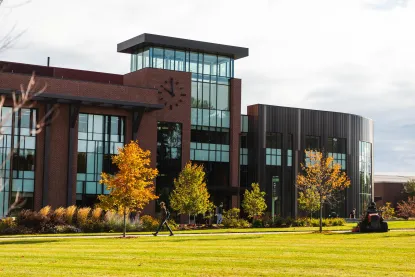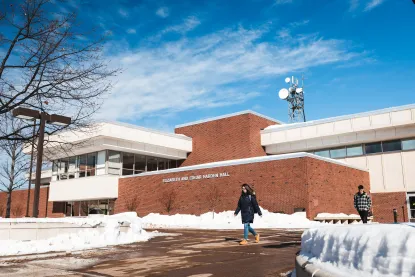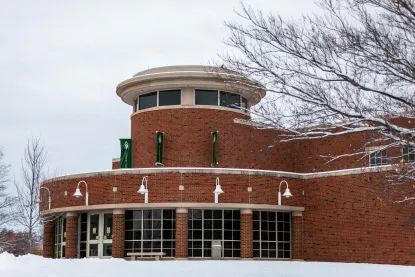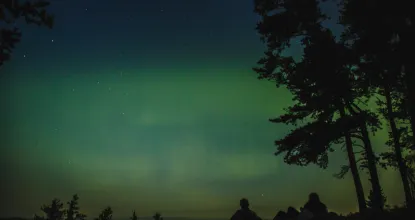Northern Michigan University’s physical campus is made up for more than 50 facilities. It is located just minutes from the shore of Lake Superior and from downtown Marquette, Michigan. Some areas of interest to the pre-professional program include:
Image

Jamrich Hall
Planning for Jamrich Hall started in 2009 with the goal of "providing an efficient, state-of-the-art facility that improves academic delivery, maximizes building use and reduces overall operational and maintenance costs."
Jamrich Hall officially opened on Aug. 18, 2014 as a replacement to the old Jamrich Hall. This 133,000 square foot state-of-the-art building features a new, 3-story classroom facility with a connector walkway to the NMU Learning Resources Center. Some of the features include:
- A 500-seat lecture hall with a prominent stage
- Three 80-seat lecture rooms with tiered seating
- 24 active learning classrooms designed to encourage collaborative learning
- 106 administrative offices and support areas
- Three meeting rooms
- Nine teaching assistant suites
- Six informal learning areas in the large corridor areas
- Starbucks
Jamrich houses five academic department offices (English, Criminal Justice, Sociology and Anthropology, Social Work, and the Math and Computer Science) and is LEED certified, meaning that it's construction meets the standards of sustainability and energy efficiency set forth by the U.S. Green Building Council.
Image

Harden Hall/Lydia Olson Library
The award-winning Lydia Olson Library is located on the second and third floors of the Elizabeth and Edgar Harden Hall. It contains thousands of books, journals and magazines, national and international newspapers in print and online, access to numerous proprietary databases, U.S. and Michigan government publications, maps, a pre-K to 12 teacher resource room and multi-media materials. The library catalog, featuring magazines and books, as well as hundreds of specialty peer-reviewed journals can be searched online at the Library Digital Catalog, library.nmu.edu.
Recently, a virtual reality section has been added to the Lydia Olson Library to highlight recent advancements in the field of VR.
Library staff are available to assist with reference and research questions and to locate materials within the library and online. Reference librarians will also answer questions via instant messaging, e-mail or phone.
Study carrels, tables and relaxing seating areas are placed around the library. A number of small classrooms and conference rooms are also housed here.
Services include public computers, photocopy machines, audio-visual and multimedia equipment, microfische readers and printers, and machinery for laminating and creating transparencies.
Edgar L. Harden was NMU's president from 1956-1967.
Image

Seaborg Science Complex
The Seaborg Science Complex is made up of two buildings: Luther S. West Science Facility and Kathleen Shingler Weston Hall. The Glenn T. Seaborg Center in West Science is one of 33 designated mathematics/science centers in the State of Michigan.
The complex houses the School of Nursing and the Biology, Chemistry, Clinical Sciences, Earth, Environmental and Geographical Sciences, Physics and Speech, and Language and Hearing Sciences Departments.
Classes related to these disciplines, and others, are held in the building. It features standard classrooms, interactive distance learning classrooms, large lecture halls, more than two dozen state-of-the-art laboratories, the NMU Speech-Language and Hearing Clinic, an auditorium, greenhouse, observatory and science-related displays.
Special programs like Summer College for Kids, regional conferences and public presentations are held in the complex. It is linked from West Science to Harden Hall via underground tunnel.
The Seaborg NASA (National Aeronautic and Space Agency) Educator Resource Center provides materials, workshops and activities for students, educators and community groups. In addition, the Seaborg Center Teacher Resource Room offers mathematics, science, language arts, special education and science lab materials that students, faculty and area teachers can borrow for classroom use.
The complex is named for Glenn T. Seaborg, an Ishpeming native who discovered plutonium and 10 other elements. He was awarded the Nobel Prize for chemistry in 1951 (with co-discoverer Edwin McMillan) and the 1991 National Medal of Science. Luther S. West served as the head of Northern’s Biology Department for 27 years. Kathleen Shingler Weston was one of NMU's first female graduates (1929) who went on to complete a medical degree. She became part of the team that developed the Salk polio vaccine and was honored by President Lyndon B. Johnson as one of the nation's “Outstanding Medical Women.”
The campus was named one of the “most unwired” (wireless) campuses in the United States in 2005. It is also completely wired.
The campus’s main quad, or academic mall as it is called at NMU, consists of the Learning Resources Center and Olson Library, Jamrich Hall, the Seaborg Science Complex and the Hedgcock Student Service Center. The arts plaza is right down the sidewalk from Jamrich and includes Forest Roberts Theatre, Thomas Fine Arts and McClintock buildings. The other main academic facilities are Whitman Hall and the Jacobetti Complex.
There are 10 residential areas on the campus. The campus also features several high-end specialty computer labs, a speech and hearing clinic, two art galleries, two on-campus radio stations, a public TV station, a university center with a bookstore, and one of the premier sports complexes of the Midwest, which includes the Superior Dome – the largest wooden dome in the world.
One aspect of the NMU campus that students say they enjoy is that everything is within easy walking distance.
